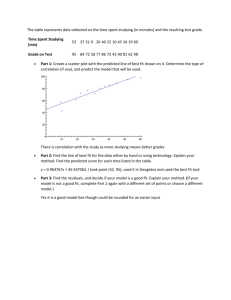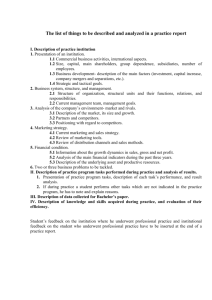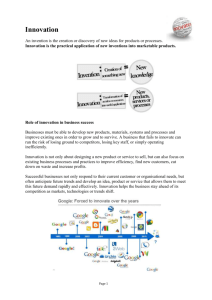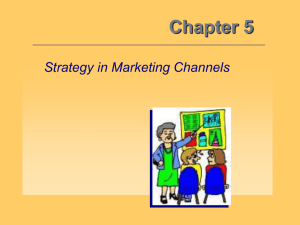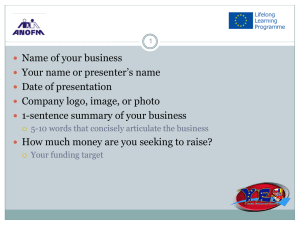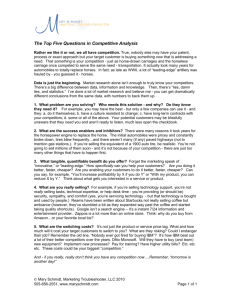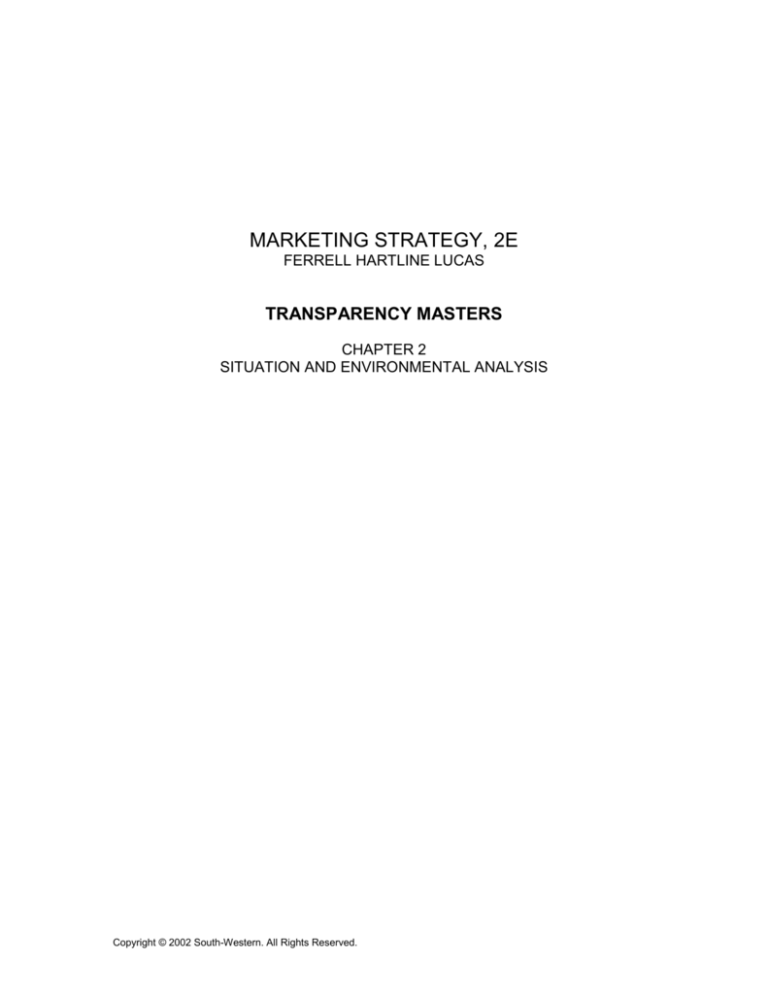
MARKETING STRATEGY, 2E
FERRELL HARTLINE LUCAS
TRANSPARENCY MASTERS
CHAPTER 2
SITUATION AND ENVIRONMENTAL ANALYSIS
Copyright © 2002 South-Western. All Rights Reserved.
TM 2-1
EXHIBIT 2.1
COMPONENTS OF A SITUATION ANALYSIS
The Internal Environment
Review of current objectives, strategy, and performance
Availability of resources
Organizational culture and structure
The Customer Environment
Who are our current and potential customers?
What do customers do with our products?
Where do customers purchase our products?
Why (and how) do customers select our products?
Why do potential customers not purchase our products?
The External Environment
Competitive pressures
Economic growth and stability
Political trends
Legal and regulatory issues
Changing technology
Cultural trends
Copyright © 2002 South-Western. All Rights Reserved.
TM 2-2
EXHIBIT 2.2
RELATIONSHIP AMONG ENVIRONMENTS IN A SITUATION ANALYSIS
Copyright © 2002 South-Western. All Rights Reserved.
TM 2-3
EXHIBIT 2.3
A FRAMEWORK FOR ANALYZING THE INTERNAL ENVIRONMENT
1. Review of Current Marketing Objectives, Strategy, and Performance
a. What are our current marketing goals and objectives?
b. Are our marketing goals and objectives consistent with the mission, goals, and objectives of
the firm? Are they consistent with recent changes in the customer or external
environments? Why or why not?
c. How are current marketing strategies performing in terms of sales volume, market share,
profitability, and communication (e.g., awareness and preference) objectives?
d. How does our current performance compare to that of other firms in the industry? Is the
performance of the industry as a whole improving, or is it declining? Why?
e. If our performance is declining, what is the most likely cause? Are our marketing objectives
inconsistent? Is the strategy flawed? Was the strategy poorly implemented?
f. If our performance is improving, what actions can we take to ensure that our performance
continues to improve? Is the improvement in performance due to a better-than-anticipated
environment or to superior planning and implementation?
2. Review of Current and Anticipated Organizational Resources
a. What is the state of our current organizational resources (e.g., financial, human,
experience, relationships with key suppliers or customers)?
b. Are these resources likely to change for the better or for the worse in the near future?
c. If the changes are for the better, how can we utilize these added resources to our
advantage in meeting customer needs better than competitors?
d. If the changes are for the worse, what can be done to compensate for these new
constraints on our resources?
3. Review of Current and Anticipated Cultural and Structural Issues
a. What are the positive and negative aspects of the current and anticipated culture of the
firm?
b. What issues related to internal politics and power struggles might affect our marketing
activities?
c. What is the overall position and importance of the marketing function as seen by other
functional areas? Are key executive positions expected to change in the future?
d. How will the overall market orientation of the firm (or lack thereof) affect our marketing
activities?
e. Does the firm emphasize a long-term, or a short-term planning horizon? How will this
emphasis affect our marketing activities?
f. Currently, are there any positive or negative issues with respect to motivating our
employees, especially those in customer-contact positions (i.e., sales, customer service)?
Copyright © 2002 South-Western. All Rights Reserved.
TM 2-4
EXHIBIT 2.4
THE EXPANDED 5W MODEL FOR CUSTOMER (TARGET MARKET) ANALYSIS
1. Who Are Our Current and Potential Customers?
a. What are the demographic, geographic, and psychographic characteristics of our
customers?
b. Who actually purchases our products?
c. Do these purchasers differ from the users of our products?
d. Who are the major influences of the purchase decision?
e. Who is financially responsible for making the purchase?
2. What Do Customers Do with Our Products?
a.
b.
c.
d.
e.
In what quantities and in what combinations are our products purchased?
How do heavy users of our products differ from light users?
Are complementary products used during the consumption of our products?
What do customers do with our products after consumption?
Are customers recycling our products or our packaging?
3. Where Do Customers Purchase Our Products?
a. From what types of intermediaries are our products purchased?
b. Does electronic commerce have an effect on the purchase of our products?
c. Are customers increasing their purchasing from nonstore outlets, such as catalogs, home
shopping networks, and the Internet?
4. When Do Customers Purchase Our Products?
a. Are the purchase and consumption of our products seasonal?
b. To what extent do promotional events affect the purchase and consumption of our
products?
c. Do the purchase and consumption of our products vary based on changes in
physical/social surroundings, time perceptions, or the purchase task?
5. Why (and How) Do Customers Select Our Products?
a. What are the basic features provided by our products and competitors’ products?
b. What customer needs are fulfilled by the benefits provided by our products and
competitors’ products?
c. How well do our products and competitors’ products meet the comprehensive set of
customer needs?
d. How are the needs of customers expected to change in the future?
e. What methods of payment do customers use when making a purchase?
f. Are customers prone to developing close, long-term relationships with us and our
competitors, or do they buy in a transactional fashion (based primarily on price)?
6. Why Do Potential Customers Not Purchase Our Products?
a. What are the basic needs of noncustomers that are not being met by our products?
b. What are the features, benefits, or advantages of competing products that cause
noncustomers to choose them over our products?
c. Are there issues related to distribution, promotion, and pricing that cause customers not to
purchase our products?
d. What is the potential for converting these noncustomers to our products?
Source: Adapted from Donald R. Lehmann and Russell S. Winer, Analysis for Market Planning (Plano, TX: Business
Publications, Inc., 1988), 89-96.
Copyright © 2002 South-Western. All Rights Reserved.
TM 2-5
EXHIBIT 2.5
A FRAMEWORK FOR ANALYZING THE EXTERNAL
1. Competitive Pressures
a. Who are our major brand, product, generic, and total budget competitors? What are their
characteristics in terms of size, growth, profitability, strategies, and target markets?
b. What are our competitors’ key strengths and weaknesses?
c. What are our competitors’ marketing capabilities in terms of products, distribution,
promotion, and pricing?
d. What response can we expect from our competitors if environmental conditions change or if
we change our marketing strategy?
e. Is this competitive set likely to change in the future? If so, how? Who are our new
competitors likely to be?
2. Economic Growth and Stability
a. What are the general economic conditions of the country, region, state, and local area in
which our firm operates?
b. Overall, are customers optimistic or pessimistic about the economy?
c. What is the buying power of customers in our target market(s)?
d. What are the current spending patterns of customers in our target market(s)? Are
customers buying less or buying more of our product, and why?
3. Political Trends
a. Have recent elections changed the political landscape within our domestic or international
markets? What type of industry regulations do newly elected officials favor?
b. What are we doing currently to maintain good relations with elected political officials? Have
these activities been effective? Why or why not?
4. Legal and Regulatory Issues
a. What charges in international, federal, state or local laws and regulations are being
proposed that would affect our marketing activities?
b. Do recent court decisions suggest that we should modify our marketing activities?
c. Do the recent rulings of federal, state, local, or self-regulatory agencies suggest that we
should modify our marketing activities?
d. What effect will changes in global trade agreements (e.g., NAFTA and WTO) have on our
international marketing opportunities?
5. Changing Technology
a. What impact has changing technology had on customers?
b. What technological changes will affect the way we operate or manufacture our products?
c. What technological changes will affect the way we conduct marketing activities, such as
distribution and promotion?
d. Are there any current technologies that we are not using to their fullest potential in making
our marketing activities more effective and efficient?
e. Do any technological advances threaten to make our product(s) obsolete? Does new
technology have the potential to satisfy previously unmet or unknown customer needs?
6. Cultural Trends
a. How are society’s demographics and values changing? What effect will these changes
have on our product(s)? pricing? distribution? promotion? people?
b. What problems or opportunities are being created by changes in the diversity of customers
and employees?
c. What is the general attitude of society about our industry, company, and product(s)? Could
we take actions to improve this attitude?
d. What consumer or environmental groups could intervene in the operations of our industry
or company?
e. What ethical issues should we address?
Copyright © 2002 South-Western. All Rights Reserved.
TM 2-6
EXHIBIT 2.6
MAJOR TYPES OF COMPETITION
Brand
Competitors
Sport utility vehicles
(need = transportation)
Soft drinks
(need = thirst)
Movies
(need = entertainment)
Colleges
(need = education)
Ford Expedition
Ford Explorer
GMC Yukon
Coca-Cola Classic
Pepsi Cola
Dr. Pepper
Titanic
American Beauty
Star Wars
Colorado State
Samford
Notre Dame
Product
Competitors
Minivans
Passenger cars
Trucks
Tea
Orange juice
Bottled water
Cable TV
Pay-per-view
Video rental
Trade School
Community college
Copyright © 2002 South-Western. All Rights Reserved.
Generic
Competitors
Rental cars
Motorcycles
Bicycles
Tap water
Athletic event
Video arcade
Concerts
Correspondence
school
CD-ROM
Total Budget
Competitors
Vacations
Debt reduction
Remodeling
Candy
Gum
Potato chips
Shopping
Reading
Internet
New car
Vacation
Investments
TM 2-7
EXHIBIT 2.7
TRENDS IN THE SOCIOCULTURAL ENVIRONMENT
Demographic Trends
Aging of the American population
Decline in the teen population (as a percentage of the total population)
Increasing number of single-member/individual households
Increasing participation of women in the workforce
Increasing number of single-parent families
Increasing population diversity, especially in the number of Hispanic Americans
Increasing legal immigration
Polarization of income levels (decline of the middle class)
Lifestyle Trends
Clothing has become more casual, especially at work
Americans have less time for leisure activities
Spending time at home is more common
Less shopping in malls, more shopping from home
Growing focus on health and nutrition
Time spent watching television has declined
Time spent using computers has increased
Still growing popularity of sport utility vehicles
Changes in Cultural Values
Less focus on “me-oriented” values
More value-oriented consumption (good quality, good price)
Importance of maintaining close, personal relationships with others
Increasing importance of family and children
Increasing concerns about the natural environment
Giving back to the community
Less tolerance of smoking in public places
More tolerance of individual lifestyle choices
Copyright © 2002 South-Western. All Rights Reserved.


